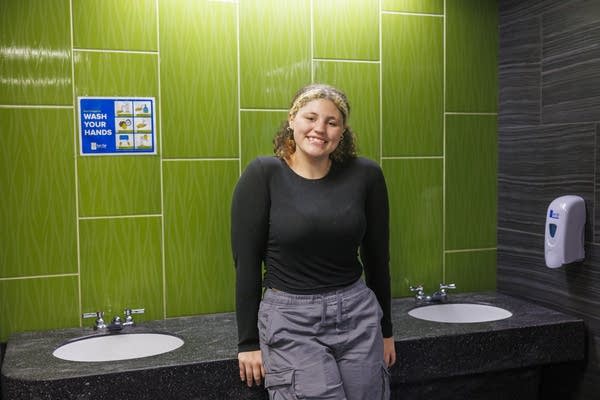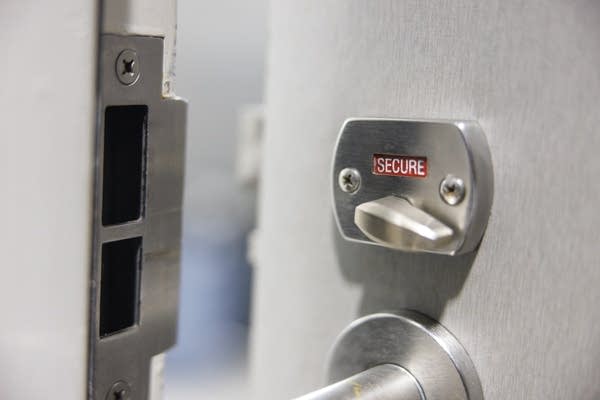In St. Paul schools, gender-neutral bathrooms have proven safer for all students

Go Deeper.
Create an account or log in to save stories.
Like this?
Thanks for liking this story! We have added it to a list of your favorite stories.
In 2016, Johnson Senior High School in St. Paul made a choice that was ahead of its time: to remove gendered bathrooms and install single-occupancy, gender-neutral restrooms.
It’s now a topic of political debate in many places, but while some are questioning whether schools should have gender-neutral bathrooms, Johnson Senior High School has had them long enough to have answers on the impact they have on students.
When you walk through the front door of the building, the bathrooms, in black and green tile, are one of the first things you see. They’re integrated into the hallway: a line of completely private stalls with floor to ceiling doors and no see-through gaps.
The sinks are communal and the door locks have indicators on both the inside and outside to show whether or not a stall is occupied. There’s a wheelchair-accessible stall with sinks for ritual washing and a small closet for students who want to use the stalls for prayer.
Turn Up Your Support
MPR News helps you turn down the noise and build shared understanding. Turn up your support for this public resource and keep trusted journalism accessible to all.
It’s simultaneously more private and more open than the typical gendered American public school restroom.
Tom Parent, who is executive director of operations for the district, said the design was intentional and new.
“It was a flipping of the mentality from an institutional, ‘How do we provide this amenity at the greatest quantity?’ to ‘How do we do this in a way that actually meets the needs of kids developmentally in the school culture as a whole?’” Parent said.
The gender-neutral restrooms are now the model not just at Johnson, but at 14 schools in the district — including elementary and middle schools.
“We heard from the student leadership group here about the negative impacts that the bathrooms had on the school experience,” Parent said. “Kids didn't feel safe or respected (with the old model). They avoided going to the bathroom all day, because they didn't feel like that was a spot where they could feel safe and supported.”
Char Alexander is a sophomore at Johnson. She said the school’s old restrooms were dark and dingy.

The huge gaps under the doors sometimes made her feel unsafe — kids sometimes passed their phones underneath. School leaders said the restrooms were places where bullying, vandalism and smoking sometimes happened.
The new bathroom model isn’t perfect — sometimes an inconsiderate classmate will leave a mess. But Char said the new bathrooms feel more inclusive, not just for gender nonbinary students.
“It’s also inclusive to people who just don't feel like they want to go to the bathroom where the stalls are open,” she said.
Char said the newer bathrooms feel cleaner, lighter, more open, easier to access and safer. She also said the lighting makes them a preferred spot to film TikTok videos.
“The lighting in the bathrooms is actually amazing,” Char said. “The bathroom TikToks are very real whether you do them off the sink or whether you do them in the mirror. Or the actual stall itself. The lighting falls on you really good.”
St. Paul school leaders said the number of kids who felt unsafe in restrooms was reduced by more than half when they changed the design to gender-neutral single-stall facilities.
There are fewer students smoking in bathrooms, less vandalism, less bullying, fewer lines and more kids washing their hands. When districts around the state were dealing with broken plumbing and soap dispensers from the Devious Licks social media trend a few years ago, Johnson Sr. High saw no vandalism.

Assistant principal Kevin Davis said the new model is better than what the school had previously.
“This is far more accessible to kids … nobody has to wait anymore … a lot of our staff use them too because of the convenience, really,” Davis said.
“Now that you have a space where people are actually using it, yes, you go through so many more paper towels and much more toilet paper because kids are much more comfortable being here. And so it does take a little more effort on a custodial crew to make sure that we’ve got this clean, beautiful space that kids can use.”
‘Trans advocacy is advocacy for everyone’
A group of Minnesota lawmakers this last session worked to get money to schools that want to install gender-neutral restrooms in their schools. State Rep. Alica ‘Liish’ Kozlowski, DFL-Duluth, sponsored the legislation, arguing it would “destigmatize as well as support” students.
“That’s good for LGBTQ students as well students that have accessibility needs … students with physical disabilities, (students who are) caretakers of a different gender, families with small children — the list goes on and on,” Kozlowski said.
The bill, which was passed as part of a larger omnibus package, provides grants of up to $75,000 per site to help schools cover the cost of renovating or constructing single-stall, gender-neutral restroom facilities.
Duluth Public Schools will be one of the first recipients of the grant money. School officials there said that they will start the planning and design process next year, and that the plan is to get input from students on how the restrooms should look and function.

Bill sponsors argued gender-neutral, single-stall restrooms would be particularly beneficial in making schools safer and more inclusive for LGBTQ+ students.
“It was really important to us to say that we have a right to be free from harassment, free from anything other than being able to use the bathroom in peace,” said State Rep. Leigh Finke, DFL-St. Paul, who was part of the coalition of lawmakers that prioritized the bill.
A 2013 national school climate survey of thousands of LGBTQ+ students found nearly two-thirds of transgender students avoided using school bathrooms because they felt unsafe or uncomfortable, compared to only 40 percent of all other student groups.
For Finke, legislation that prioritizes trans students is beneficial for all students.
“Trans advocacy is always advocacy for everyone,” she said.
Back in St. Paul, students and school officials said the gender-neutral bathrooms weren’t just safer for non-binary students, they were safer for everyone.
“Good design is good design,” said St. Paul Public Schools communications specialist Ryan Stanzel. “And inclusivity is about everything.”
MPR News reporter Kyra Miles contributed to this story.



